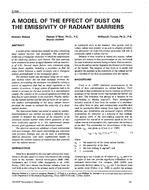Description
A model of the radiant heat transfer in attics containing dusty radiant barriers was developed. The geometrical model was a triangular enclosure in which the temperatures of the enclosing surfaces were known. The dust particles were simulated as areas of equal diameter with an emissivity of 0.85. Several shape factors were calculated using shape factor algebra, including a procedure to find the shape factor between a small rectangle and a triangular surface perpendicular to the rectangular plane. The thermal model was developed using the net radiation method where the net heat exchange between the surfaces surrounding the enclosure was found by solving a system of equations that had as many equations as the number of surfaces. A large system of equations had to be solved to account for the dust particles in a representative sample. The solution of the system of equations provided the heat flux for each element of the enclosure. Finally, replacing the radiant barrier and the dust particles for an equivalent surface corresponding to the dusty radiant barrier provided the means to estimate the emissivity of a dusty radiant barrier. The theoretical model was tested to asses its validity. Experimentation was carried out using a reflection emissometer to measure the increase of the emissivity of an aluminium radiant barrier when known quantities of dust were artificially applied to it. The experimental results showed good agreement with the theoretical model. The effective emissivity exhibited a linear relationship with dust coverage. This simple relationship was consistent with previous findings and can be used in determining effective emissivity with more sophisticated models to simulate the random location of random-size dust particles over the radiant barrier.
KEYWORDS: aluminium, foils, dust, particles, emissivity, calculating, heat flow, temperature, performance, experiment
Citation: ASHRAE Trans. 1994, Vol.100, Part 2, Paper number 3786, 23-30, 9 figs., refs.
Product Details
- Published:
- 1994
- File Size:
- 1 file , 850 KB
- Product Code(s):
- D-17364




